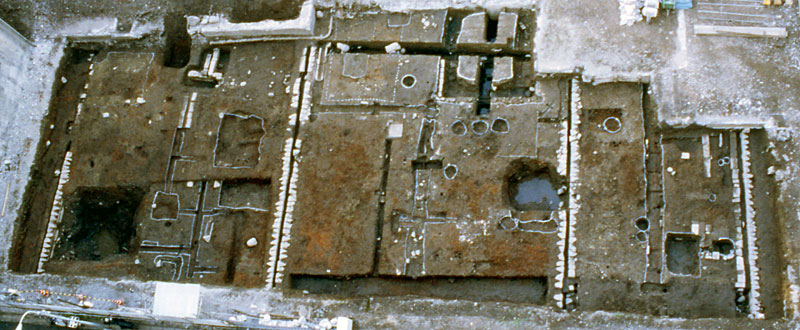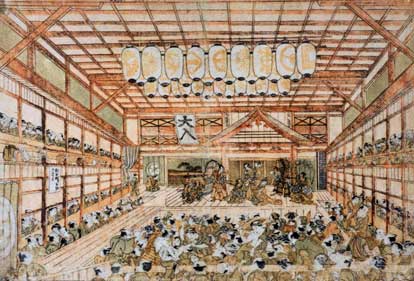Nihonbashi Nichōme, Kyōbashi Nichōme, Nihonbashi Itchōme:
Edo period Kabuki tickets, recovered from each of the city's three licensed theaters, are precious clues to the performing arts and amusements of the day.

Panorama of the Kyōbashi Nichōme site (from the south)
The arrangement of city lots partitioned by stone-lined gutters is easily discerned. The exposed living floor was abandoned at the end of the Edo period.



Doma fuda (ticket) for the Nakamura-za theater (left)
Recovered from a storage pit abandoned in the early eighteenth century at the Nihonbashi Itchōme site. Length 15.7 cm, width approximately 5.1 cm, 1.0 cm thick.
Kiriotoshi fuda (ticket) for the Morita-za theater (center)
Recovered at the Kyōbashi Nichōme site in a stratum dating from the start to the mid eighteenth century. The characters "kiriotoshi" are written in ink. Length 13.7 cm, width approximately 5.7 cm, 0.5 cm thick.
Kiriotoshi fuda (ticket) for the Ichimura-za theater (right)
Recovered from a storage pit abandoned in the early eighteenth century at the Nihonbashi Nichōme site. Length 13.7 cm, width approximately 6.9 cm, 0.9 cm thick.
 Interior of the Moritaza theater (ukiyo-e)
Interior of the Moritaza theater (ukiyo-e)
Members of the audience are vividly depicted as they enjoy a Kabuki performance. In the collection of the Tsubouchi Memorial Theatre Museum, Waseda University (collection no. 201-0891).
Nihonbashi Nichōme, Kyōbashi Nichōme, and Nihonbashi Itchōme Sites, Chūō Ward, Tokyo
Kabuki in Edo
At the start of the Edo period, the Bakufu licensed Kabuki performances only at the Nakamuraza, Ichimuraza, Moritaza, and Yamamuraza theaters, which opened successively within Chūō Ward of modern Tokyo. The Yamamuraza was subsequently abolished in the fourth year of Shōtoku (1714), and the remaining three, known as the "three theaters of Edo" (Edo sanza), continued holding performances in this district until removed to Asakusa from Tempō 13 (1842) under the Tempō Reform.
Unearthed theater tickets
At Nihonbashi Nichōme, a kiriotoshi fuda (ticket) for the Ichimuraza was unearthed from a cellar dating from the start of the eighteenth century; at Kyōbashi Nichōme, a kiriotoshi fuda for the Moritaza was recovered in a stratum dating from the start to the mid eighteenth century; at Nihonbashi Itchōme, a doma fuda for the Nakamuraza was unearthed from a cellar dating from the start of the eighteenth century. All are wooden theater tickets from the mid Edo period. Kiriotoshi and doma are the names of seating sections within the theater, with kiriotoshi being unreserved seats to the rear of the hall in which as many spectators as possible were packed. Admission tickets were sold at the theater's shikiriba (business office) or at tea houses in the neighboring area. Doma are thought to be slightly more expensive than kiriotoshi seats, but for the period from which the recovery was made their nature is not well understood. The term doma fuda is not known from historical records, but there are documentary examples of the term kiriotoshi fuda, and the term doma fuda is applied based on analogy.
Urban sites yielding theater tickets
All locations are urban sites in the low-lying commoner areas. The Nihonbashi Nichōme site is on land granted to the family of Kushi Motoshikibu, physician to the shogun's household. The Kyōbashi Nichōme site was known throughout the Edo period as "Suzuki-chō," a neighborhood having many green grocers and establishments serving food and drink. The Nihonbashi Itchōme site, called "Yorozuya-chō" in Edo times, was an urban district with a wide variety of wholesale shops. From these urban sites numerous cellars, warehouses, and other remains symbolic of a mercantile district have been found, along with many features accompanying residence such as wells, buildings, septic tanks, wooden culverts for sewage, and stone-lined gutters that were part of a standardized system of city lots.
Admission tickets for the three theaters of Edo have been found to date only at these three sites, and are extremely important materials as heritage directly linked with Kabuki, a representative element of Japan's traditional culture. (Nakamitsu Katsuaki)
